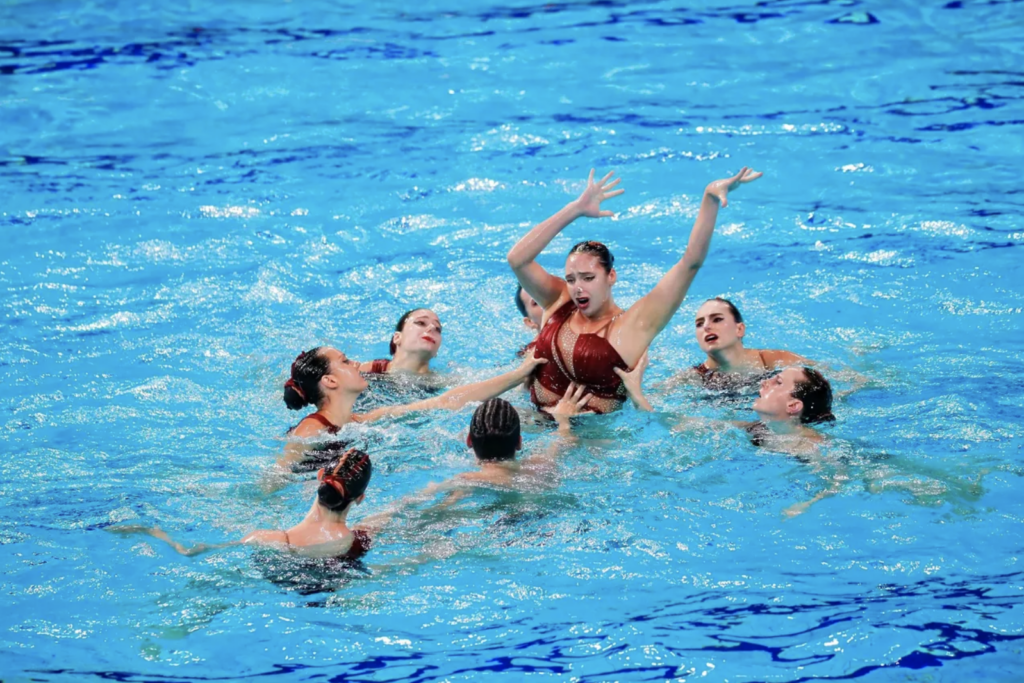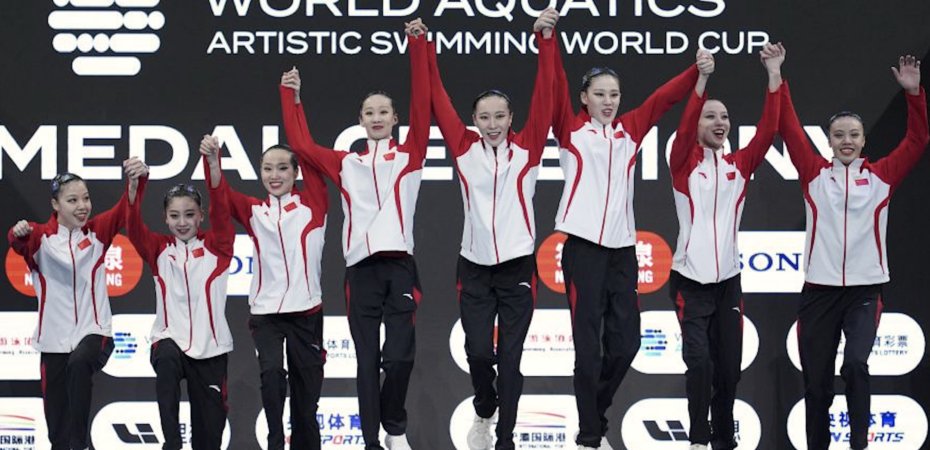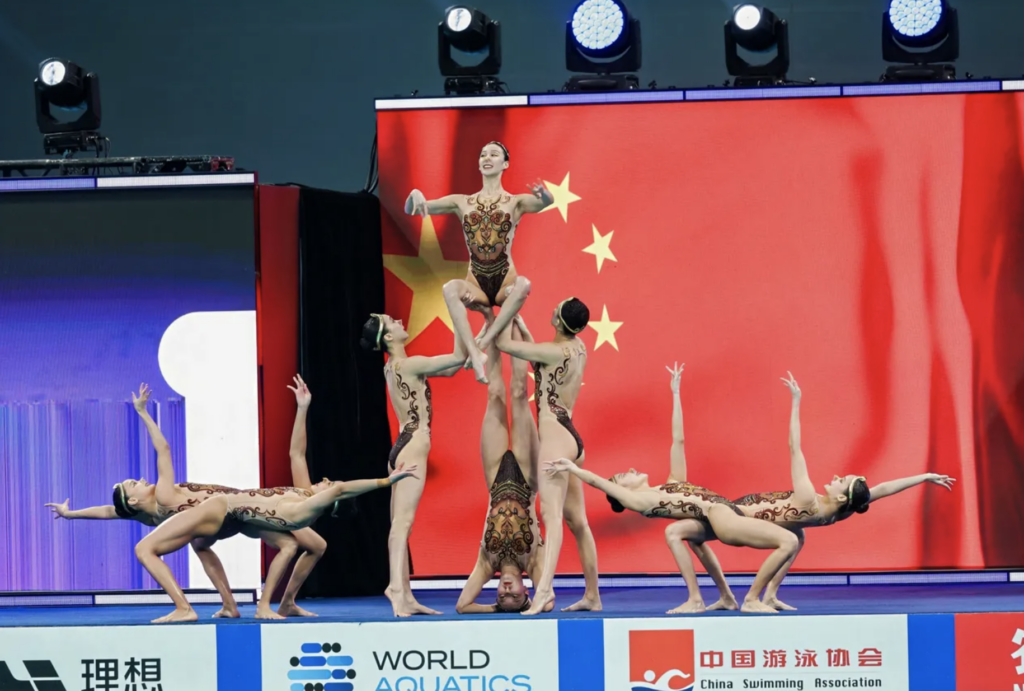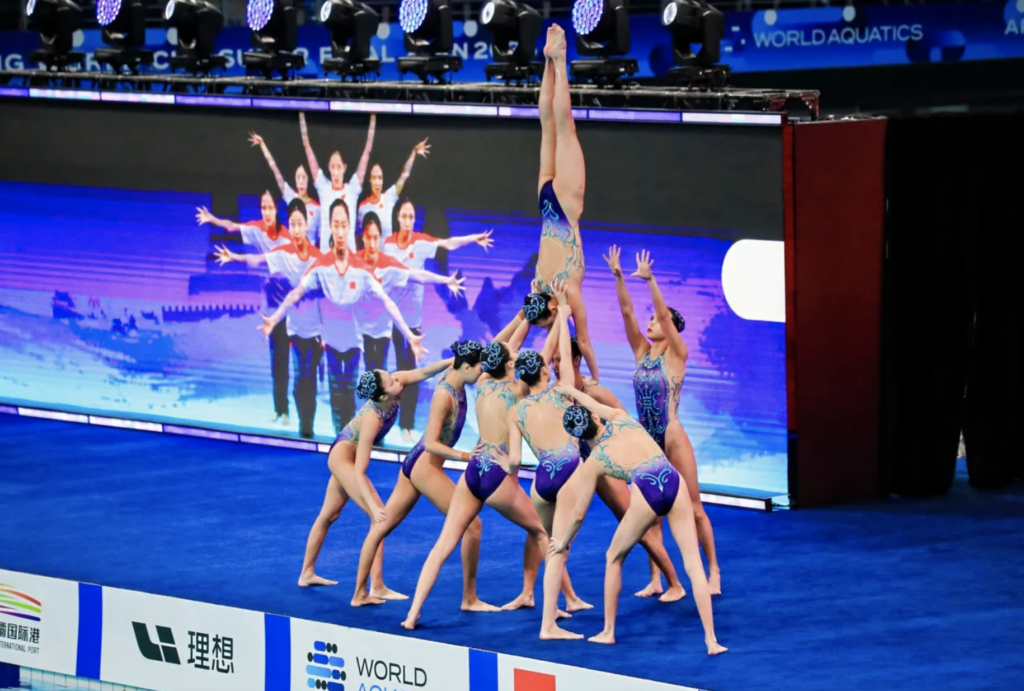The 2025 World Cup Super Final in Xi’an concluded with a commanding statement from the reigning World and Olympic champions: China remains the team to beat across nearly every event.
Competing on home soil, China delivered a performance of remarkable quality and consistency, reaffirming its dominance by medaling in every event, with a total of seven golds – including in the five Olympic routines –, three silvers, and one bronze.
As expected, the team unveiled two new choreographies: a technical team program inspired by “Wukong” and an acrobatic routine titled “The Soul of the Terracotta Warriors.” The latter, in particular, stood out as one of the highest-level performances of the meet.
Scoring a huge 233.0430, the routine received eight 10s, including five in artistic impression and a clean sweep in the choreography/musicality category, with only tens counting towards the final score. It was a performance of maximum precision, astonishing acrobatics, and superb visual impact, as the new theme paid a fitting tribute to the competition’s host city.
In the technical team, the “Black Myth: Wukong” program was equally world-class, as the Chinese athletes delivered textbook Technical Required Elements, clear execution, outstanding synchronization, and tight connections and pattern changes. Despite an early basemark on the opening acrobatic movement, the team secured gold ahead of Spain by just over one point and a score of 277.2258.
For the free team, China retained the Olympic-winning “Gravitation” routine, albeit slightly modified to meet this year’s rule updates. It remains a high-impact program, and its final appearance will come at the World Championships in Singapore. Head coach Zhang Xiaohuan has already come up with ideas for the new program, which she has stated, “only needs to be polished and refined.”
After the free team’s win, Zhang was visibly emotional, as the team’s training only moments before was anything but smooth sailing:
“This gold medal lifts a huge weight off our shoulders,” she admitted. “Chang Hao was injured during training and she showed incredible grit to compete through injury, and while our routine still needs refinement, the team’s courage under pressure was extraordinary.”
“The team executed the routine with remarkable composure, just like in our daily training sessions. Today we delivered it steady and clean,” said Chang. “My neck rotation is still slightly [limited], so I’ll need treatment tonight. For the acrobatic team tomorrow, our focus is hitting every lift perfectly.”
Olympic champion Chang Hao, the team’s featured swimmer, ultimately pushed through and competed in all three team routines as planned. She remains a crucial force for the squad, as she swam with characteristic calm, shielding her teammates from added stress and showing the leadership of a seasoned athlete.
Also remarkable was China’s continued commitment across all three team routines to outstanding, attention-grabbing and impressive deckworks that left most in awe. It’s a style that echoes earlier decades of the sport, and honestly a very welcomed choice as many other nations now start in the water.
All in all, China’s superiority in the team events in Xi’an was nothing short of staggering. From execution to artistry to sheer difficulty, the team is in a league of its own, operating at a level no one else is touching right now. The level of precision, synchronization, height, cohesion and command over every element is unmatched. Unless something dramatic happens, they will be incredibly hard to beat in Singapore.
At the individual level, Xu Huiyan, only 19 years old, emerged as one of the competition’s most valuable athletes. She competed in six events, taking home five golds and one bronze, and continued to establish herself as one of the new central figures for the Chinese team.
“The intensity of this competition was quite high for me, with a packed schedule from morning till night,” she said after the free solo final. “With better stamina, I could have controlled my movements and techniques more precisely and stayed more focused. But when my energy runs low, like today, it really affects my performance.”

Spain delivered another strong set of performances, medaling in eight events in Xi’an. The nation once again proved untouchable in the mixed duet events, claiming gold in both technical and free, just as in the Soma Bay and Markham World Cups. And yet, no top prize money. Apparently, dominating an entire category all season just isn’t quite what the system is looking for. Fascinating!
Indeed, the Super Final not only wrapped up the World Cup circuit but also determined the final overall rankings in each category, used to award end-of-season prize money based on performance and attendance through each stop. At the time of this writing, the final mixed duet rankings are still not published on AQUA’s website, but, it was quite surprising when, during the live stream, Spain was only awarded the second-place check.
To be clear, this isn’t an attack on any nation. But when a country that didn’t medal at the Super Final and only won a single bronze over the last three World Cup stops walks away with the largest check, while another racks up six golds over the same three stops, with the same athletes in the water, and misses out, something doesn’t add up.
And, if the results can be outweighed, perhaps, by the fact that, on one occasion, an athlete from the mixed duet group wasn’t listed as reserve for one event despite swimming and winning the other, it’s understandable why the system can feel confusing. Spain’s results speak for themselves. Maybe it’s time the rules, and how they’re applied, were just as clear.
Anyways, back to Xi’an. In the free routine, Dennis Gonzalez Boneu and Iris Tio again earned six 10s for their Led Zeppelin’s “Babe I’m Gonna Leave You” choreography, including three in performance, two in choreography and musicality, and one in transitions. Their consistency and outstanding performance this season have firmly established them as the pair to beat in the lead-up to Worlds.
Finally, Spain delivered another strong and entertaining acrobatic team routine, just as at the European Championships, where a coach card issue cost them a basemark. The Spanish athletes faced no such problems this time, and this silver medal is well-earned, especially after a grueling competition schedule packed with Europeans and World Cup stops.
Now, with the season’s heaviest stretch behind them, the team can finally breathe, regroup, and come back re-energized. Expect some fine-tuning and a few strategic adjustments ahead of Singapore.

Japan showed further signs of upward momentum, earning two silver and two bronze medals. In the technical duet, the nation returned to its Olympic pairing of Higa Moe and Sato Tomoka, perhaps signaling the end of some earlier pairing try-outs. In the free duet, it did continue with Sato and Kobayashi Uta, a proven and reliable new pairing this year.
The Japanese also closed the gap in the free team, narrowly finishing ahead of Spain for silver after significantly increasing their Degree of Difficulty (DD) from 62.438 in Markham to 67.45 in Xi’an, the highest of the event.
Vasilina Khandoshka, competing under “Neutral Athletes A,” won gold in free solo and bronze in technical solo, both with the highest degree of difficulty in the field. Her new technical routine, set to Barbra Streisand’s “Don’t Rain on My Parade”, offered an unexpected departure from her usual emotional repertoire, showing a more theatrical and playful side. Her teammates also introduced a new acrobatic team routine themed around “Circus”.
In the women’s technical solo, the battle for silver and bronze was closely contested. Only three points separated second to fourth place, with Iris Tio in silver betting on artistic impression, Khandoshka in bronze prioritizing difficulty, and Germany’s Klara Bleyer opting for a more balanced approach.
While that left her in fourth place in that event, Bleyer however found redemption in the free solo, where she returned to form as the reigning European Champion, taking silver and claiming the overall prize money.
On the men’s side, Diego Villalobos of Mexico narrowly defeated China’s Guo Muye in the technical solo by just over one point. Swimming to “La Maza” by Mercedes Sosa, Villalobos gained the edge through artistic impression.
The team of Mexico also secured a bronze in the acrobatic event with their Olympic routine “Matlalcueye”, and showed promise in duet with Fernanda Arellano and Itzamary Gonzalez placing fourth in both tech and free. It was the first outing for the pair in the latter, where they used the same choreography as their teammates in the Paris Olympic Games.
Great Britain unveiled a new free mixed duet titled “The Conflict Between Light and Darkness”, performed by Ranjuo Tomblin and Isabelle Thorpe, Olympic silver medalist in duet. Though hit by a basemark, they still earned bronze and showed great potential, serving as a strong follow-up to their technical routine, whichearned a bronze in Xi’an and silver in the recent European Championships. Tomblin also continued his momentum individually with silver in men’s free solo and bronze in tech.
Finally, credit where it’s due: the broadcast coverage in Xi’an was great. With a fairly consistent side view angle matching the judges’ perspective, minimal erratic cuts, and well-timed camera transitions, the routines were allowed to speak for themselves. Sure, there were still a bit too many shots from a distance, but it was possible, at last, to see full elements, facial expressions, and team patterns as intended. A welcome improvement and one that truly respected both the athletes and the sport.
As teams now shift their focus to the World Championships in Singapore, one thing is certain: China remains the clear frontrunner. But behind that dominance, the field is far from static. Spain’s continued rise, Japan’s steady presence, and the growing depth across multiple nations including many not even competing in Xi’an, suggest we’re in for a fiercely competitive showdown.
With just a few weeks to go, the pressure builds, the stakes rise, and all eyes turn to Singapore.
ARTICLE BY CHRISTINA MARMET
Cover photo: Sports Photo China
If you’ve enjoyed our coverage, please consider donating to Inside Synchro! Any amount helps us run the site and travel costs to cover meets during the season.





